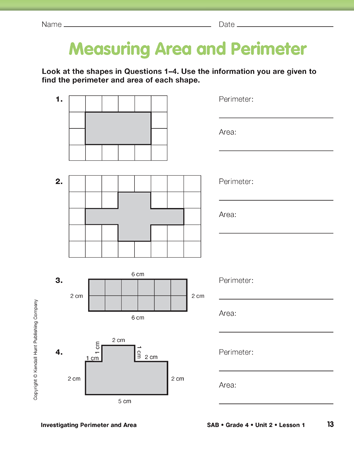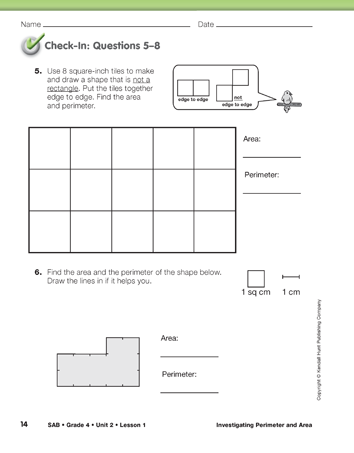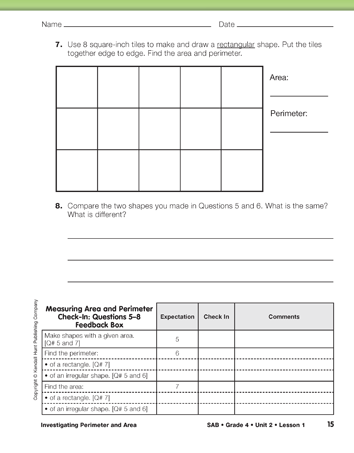Display Questions 1–4 on the Measuring Area and Perimeter pages in the Student Activity Book. Ask students to turn to this page in their Student Activity Book. Use the following discussion questions and Questions 1–2 to help students interpret the different ways measurements can be derived from the grids.
- Look at the shaded figure in Question 1. What is the perimeter of this figure? (12 centimeters)
- What strategies did you use to find the perimeter? (Possible response: I used the grid that surrounded the figure to count the number of centimeters around the shape.)
- Look at each side of the shape in Question 1. What is the measurement of each side? (Each of the long sides is 4 centimeters long, and each of the short sides is 2 centimeters long.)
- How can knowing the length of each of the sides help us find the perimeter of a shape? (You can add the lengths of all of the sides together to find the perimeter.)
- Write a number sentence to show how you can find the perimeter if you know the lengths of each side.
(4 + 2 + 4 + 2 = 8, or 4 + 4 + 2 + 2 = 8)
- Show how to use the grid to help you find the area of the shape in Question 1. (You can sketch in the lines using the grid to guide you and then count the square centimeters in the shape.) What is the area of the shape in Question 1? (8 square cm)
Ask students to work with a partner to find the perimeter of Question 2 two different ways and to compare their answers to verify their measurements. Ask students to share their solutions and their strategies with the class.
Use the following discussion questions and Questions 3–4 to help students interpret different ways measurements can be used to find area and perimeter of a shape.
- What strategy did you use to find the perimeter in Question 3? (Possible responses: I added up the lengths from all of the sides. I know that 6 + 6 = 12 and 2 + 2 = 4, so I added 12 + 4 to get the perimeter of 16 centimeters. Or, I counted the length of each side using the grid marks that were on the inside of the shape. I counted 16 centimeters for the perimeter.)
- What is the area of this shape? (12 square centimeters)
- Look at the shape in Question 4. How can you find the perimeter of this shape? (Add up the measurements of all of the sides.) What number sentence can you write to show your work?
(2 + 1 + 2 + 2 + 5 + 2 + 1 + 1 = 18 centimeters)
- What strategy can you use to find the area of this shape? (You can sketch in the grid lines using the numbers. For example, you will need to draw in lines to show that the small rectangle on the top of the shape has one row and two columns. The large rectangle on the bottom of the shape has two rows and five columns.)
Ask students to complete Check-In: Questions 5–8 individually or with a partner. Students will use the strategies they have learned to find the area and perimeter of different shapes.
Use Check-In: Questions 5–8 on the Measuring Area and Perimeter pages in the Student Activity Book to assess whether students can make a shape given a measurement and find perimeter and area of rectangles and irregular shapes [E5, E6, and E7].
Provide feedback to students about their work using the corresponding Feedback Box.















